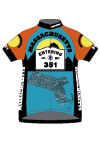In April 2022, Mike traced the march route of Civil War General William T. Sherman, using the effort to raise more than $30 thousand for cancer research at Dana-Farber as a supplement to his regular Pan-Mass Challenge (PMC) fundraising. Donations, large and small, are welcomed and can be made via this link.
Mike's route took him from Chattanooga, TN through Atlanta finishing in Savannah, GA. Eight days and 600+ miles on the road -- filled with history and exploration.
History lesson: After the battle of Chattanooga, General Grant was recalled to Washington to take command of all the Union Armies and personally lead the campaign in Virginia against Lee. Grant named Sherman, his trusted lieutenant, to take control of the Western armies. His mission -- capture the city of Atlanta.
The Rebel army also had a new commander, Joseph Johnston, a skilled defensive tactician. Johnston's strategy -- establish strong fortified positions and lure Sherman into costly frontal assaults. Sherman used his 2:1 numerical superiority to flank, or go around, Johnston's entrenched positions at Resaca and several other points after brief skirmishes. But at Kenesaw Mountain, Sherman elected try a direct assault -- and suffered significant losses. Two months of cat and mouse brought Sherman to the outskirts of Atlanta, and after several weeks of heavy fighting, Sherman succeeded in cutting every rail line into the city. The Confederates withdrew. "Atlanta is ours, and fairly won" was the message Sherman sent Grant.
The countryside between Chattanooga and Atlanta -- very rural. Outside of differences in the political signs and the roadkill (didn't know there were armadillos in Georgia), I could have easily been in Central Mass. - the terrain and pastureland were similar. Two things were constant reminders of the history: regular Georgia Historical Commission markers with details on the skirmishes and -- the railroad. The ever-present railroad that was the lifeline for both armies, to be protected and fought over.
Kenesaw Mountain was not as visually striking as Lookout, but it was easy to imagine the fierce struggle, and the havoc wreaked on the advancing Union troops from the lines of cannon and muskets on the mountain top. It was Sherman's last frontal assault of the war. I was shocked at how many people were there on Easter Sunday -- parking in the overflow lot. And I was pleased to see a black family talking about the history and importance of the place to their ten year old.
The transition into Atlanta was sudden -- no "Welcome to Atlanta" sign (Sherman probably didn't get one either). I came through Buckhead, which is fighting to separate itself from the City of Atlanta, I was struck by the irony of white Buckhead fighting for political independence from black Atlanta. It's uncomfortable being a minority not in control.
I made it a point to stay in Five Points -- right in the heart of Atlanta. Nearing my hotel, I was passed by a truck playing VERY LOUD MUSIC through open windows -- I chastised myself for my stereotyping -- I hadn't seen the driver.
I walked through a heavily black neighborhood to the John Lewis Mural -- a testament to a great man and freedom fighter. I felt more comfortable being "out of place" than I had been in Birmingham. I find I am learning as much about myself as the countryside.

